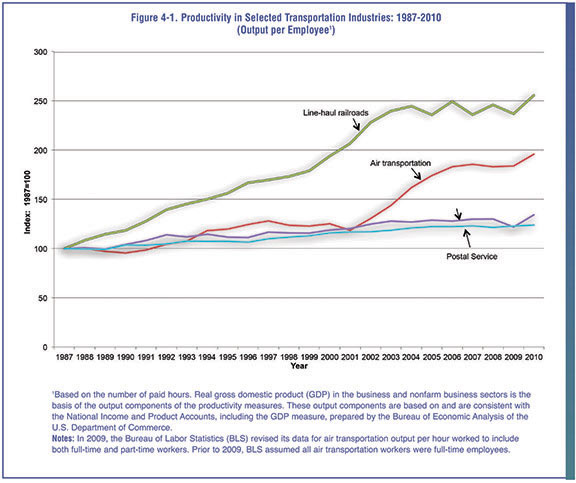Freight Facts and Figures 2012
Figure 4-1. Productivity in Selected Transportation Industries: 1987-2010
Productivity has been relatively stable after years of improvement. Between 1987 and 2010, output-per-hour worked more than doubled in line-haul railroading and grew by 34 percent in long-distance, general-freight trucking. Line-haul railroads do not include switching and terminal operations or short-distance (or local) railroads. Long-distance, general-freight trucking establishments exclude local trucking and truck operators that require specialized equipment, such as flatbeds, tankers, or refrigerated trailers.

[PDF 3.2MB]
Data represented in the figure.
Output per Employee,1 Index: 1987 = 100
| 1987 | 1988 | 1989 | 1990 | 1991 | 1992 | 1993 | 1994 | 1995 | 1996 | 1997 | 1998 | 1999 | 2000 | 2001 | 2002 | 2003 | 2004 | 2005 | 2006 | 2007 | 2008 | 2009 | 2010 | |
|---|---|---|---|---|---|---|---|---|---|---|---|---|---|---|---|---|---|---|---|---|---|---|---|---|
| Output per hour worked | ||||||||||||||||||||||||
| Air transportation | 100 | 100 | 97 | 96 | 99 | 104 | 108 | 118 | 120 | 125 | 128 | 124 | 123 | 125 | 119 | 130 | 144 | 162 | 174 | 183 | 186 | 183 | 184 | 196 |
| Life-haul railroads | 100 | 108 | 115 | 119 | 128 | 140 | 145 | 150 | 156 | 167 | 170 | 173 | 179 | 194 | 207 | 228 | 240 | 245 | 236 | 249 | 236 | 246 | 237 | 256 |
| General freight trucking, long-distance | 100 | 101 | 100 | 104 | 108 | 114 | 112 | 115 | 112 | 111 | 117 | 116 | 116 | 119 | 120 | 125 | 128 | 127 | 129 | 128 | 130 | 130 | (R) 122 | 134 |
| Postal service | 100 | 99 | 99 | 104 | 103 | 105 | 108 | 108 | 108 | 106 | 110 | 112 | 113 | 116 | 117 | 117 | 119 | 121 | 122 | 122 | 123 | 122 | 123 | 124 |
Key: R = revised
1 Based on the number of paid hours. Real gross domestic product (GDP) in the business and nonfarm business sectors is the basis of the output components of the productivity measures. These output components are based on and are consistent with the National Income and Product Accounts, including the GDP measure, prepared by the Bureau of Economic Analysis of the U.S. Department of Commerce.
Note:
In 2009, the Bureau of Labor Statistics (BLS) revised its data for air transportation output per hour worked to include both full-time and part-time workers. Prior to 2009, BLS assumed all air transportation workers were full-time employees.
Source:
U.S. Department of Labor, Bureau of Labor Statistics, Industry Productivity, available at www.bls.gov/lpc/ as of September 5, 2012.
You may need the Microsoft Excel Viewer to view Excel files on this page.
You may need the Adobe® Reader® to view the PDFs on this page.